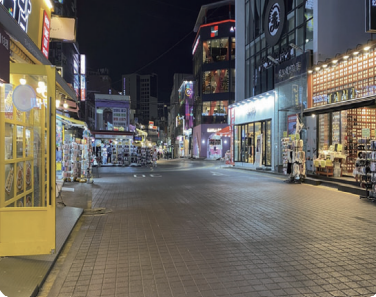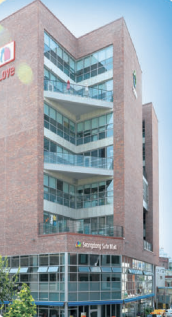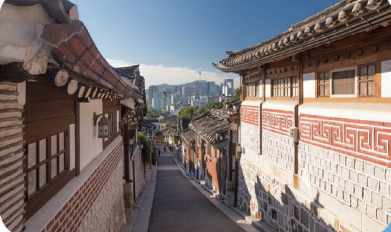All places are constantly changing. Newly built buildings replace old ones, and this new space is filled with completely different people from those who lived in this place for so long. This phenomenon frequently occurs when the region’s growth and development continue, but people are not familiar with the word gentrification that explains this phenomenon. Lately, it is easy to see the headlines of the news talking about gentrification in Hongik University’s streets (Hongdae) and Itaewon. Therefore, the Sungkyun Times (SKT) will discuss what gentrification is, how it affects people, and suggestions regarding it..
What Is Gentrification?
The Introduction of Gentrification
Gentrification is a process whereby an underdeveloped region is changed by the upper-middle class moving in, and typically displacing the current inhabitants in the process. There are three typical types of gentrification: residential, commercial, and art-led gentrification; each of which represents the area where gentrification occurs. According to the book, A Teen Who Knows Gentrification written by Chang Sung-ik, the causes of gentrification are as follows. The first factor is the social and cultural characteristics of upper-middle-class individuals who get into the areas where gentrification occurs. In contemporary society, the industry structure has changed from manufacturing to service and the industry with higher added values like infocommunications. The characteristics of members also change, and the regions are transformed to reflect their preferences; as a result, gentrification occurs. Moreover, there is an economic approach that gentrification occurs due to the characteristics of the real estate market. In the real estate market, people buy properties like land and buildings when they are at low prices and gain profits by reselling or raising rent prices when properties’ costs rise. For example, if local businesses in one area become activated since it has some cultural identity, the real estate value increases, and people who have properties will set the rent price even higher than before to gain profit. People who cannot afford this high rent price would eventually leave the place and move to another area.
Gentrification in Korea
Since different types of gentrification appear depending on each country’s situation and social circumstances, gentrification that reflects the Korean situation has also appeared. Korean style gentrification occurs strongly in the commercial space rather than the residential space. According to the Organization for Economic Cooperation and Development (OECD) statistics in 2018, the proportion of self-employed in the whole industry is 25.1% in Korea, which ranks 5th among OECD countries. According to an interview with Chang Jae-hyun, a research director from Real Today, which is a real estate research firm, when artists and small shopping complexes are crowded, it has formed a regional attraction. It becomes activated, and people rapidly move to the activated area. As a result, the commercial district with a high floating population increases in rent, shopping complexes, and buildings.
Furthermore, lots of people are interested in real estate investment, like how they can obtain profits through properties. People are likely to raise the market price to make profits in a short period, so they prefer large franchise stores. As a result, the commercial districts that used to be unique with unique stores get replaced by other typical, common stores. When a unique place becomes unified, and another unique place appears, people move to the newfound place. Then, these processes repeat because of the social circumstances with a high proportion of self-employed and increased interest in real estate investment.
Gentrification Effects
Two Aspects of Cultural Effects
According to Gentrification written by Kim Hyun-ah, a member of the 20th National Assembly, and Seo Jeong-ryul, a real estate professor at Youngsan University, gentrification shows that the place has unique and distinctive identities. It encourages people to have interests and go there. When that uniqueness attracts people, following gentrification revitalizes local businesses and social-cultural activities, creating images of the small space and furthers those of the region and having competitiveness as a tourist site. These activations, therefore, show a slow urban generation rather than fast development, trying to find and specialize identities of their regions. On the other hand, cultural whitening can occur, meaning that the diversity of culture and unique identities disappear with the space dominated by money. As the rent price rises and large franchises are introduced, the identity of the place will gradually vanish. Hongdae is a famous example of being in this cultural whitening. Hongdae used to be the symbol for an artistic place like arts, music, and handcrafts, but its unique atmosphere has become faded by heavy capital inflows since this street became popular.

Economical Effect: Whether to Activate Local Businesses
In terms of economic effects, gentrification can activate local businesses, resulting in profits. Large buildings, markets, franchises, and enterprises make local districts more luxurious. As poor commercial environments that used to be underdeveloped become improved, the area’s image can get better. Therefore, the area’s real estate price will rise, and since people who can afford that price will get in, tax income will be increased, securing local finance. Gentrification, however, cannot boost local economic activation. According to the research director at Real Today, Chang Jae-hyun, people who bought properties pay attention to whether they can increase the investment earnings rate, so they open large-scale franchises. If these large stores are continuously introduced, the streets can lose the floating population. For instance, when large stores were introduced to Hongdae, the unique markets with a floating population in Hongdae moved out to the surroundings. Loss of floating population can lead to market regression as the value falls from the increased real estate price, and the profits gradually decrease due to the long-term vacancy.
Possible Directions Regarding Gentrification
Cooperation with Residents and Local Governments
Residents like leasers, tenants, and local gover nments need to cooperate and be in harmony for their regions. To achieve this, they should get together and make a self-governing organization to discuss local problems including gentrification. In the case of Korea, some areas in Seongdong-gu manage their self-governing organizations. When people are gathered, they devise policies and arrangements regarding the issue. Cooperation for harmony is emphasized rather than the legal duty to the decisions. In particular, all members of the group must have their roles in making decisions. In the case of a local administrative agency, they should try to make people understand the policies by constantly answering their questions to release an imbalance of knowledge. Also, they should create opportunities for communication with each other to form reliability between them. According to Seoul Economic Daily, in February 2020, 69.8% of leasers in Seongsu 1-ga 2-dong agreed to participate in autonomous agreements to refrain from raising rents for local business stability. In the case of leasers, tenants, and other relevant individuals, they should keep in mind that they are important for the areas and need to participate actively in devising various opinions to solve problems. Unfortunately, there are not many self-governing organizations like the case of Seongdong-gu. Therefore, these self-governing organizations need to be expanded further by regional units. The members of the region should try and discuss to solve the problems they face with their areas.

Local Policies Which Carried Out Local Identity
Quantitative growth like establishing new buildings, large franchises, and convenient facilities plays an important role in the growth of areas. However, an area’s unique and distinctive culture is also crucial since it can attract lots of people and form identities of the regions with particular images. These cultural factors also contribute to local activation; for example, there are cultural contents called street tours to experience the region’s culture by walking around. Therefore, qualitative growth like cultural characteristics of the regions and quantitative change is important for development. Gentrification, however, can lead to the opposite direction of quantitative and qualitative growth. Therefore, local policies need to be implemented to make both growths move in the same direction.

Many social circumstances like real estate and the self-employed industry cause gentrification, resulting in social, economic, and cultural effects. Nowadays, gentrification is under discussion in many countries, including Korea, so local policies and cooperation seem necessary to bring about positive results.
